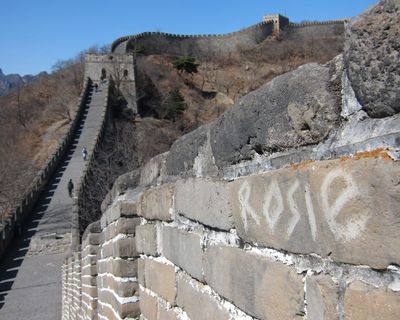China to install plastic at Great Wall for graffiti

MUTIANYU, China – It’s a U.N.-designated world heritage site, an icon of the planet’s largest civilization. Millions of tourists visit the Great Wall of China each year, and far too many of them end up leaving their mark on it.
Graffiti has plagued the Great Wall for decades. Now, China is trying a new approach to put a check on the etchers.
At the Mutianyu section of the wall northeast of Beijing, authorities have set up a free graffiti zone where they hope visitors – many of them from western countries – will scrawl on a sheet of plastic instead of walls that date back 600 years or more.
It’s too soon to know if it will work. The state-run China Daily only reported the new policy Tuesday. By Friday, the sheet of plastic inside of Tower 10 of Mutianyu had some signatures and messages from visitors, but not many.
“It’s better than them doing it all over the place,” said Jesse Ring, a tourist from Radford, Va., who visited Mutianyu on Friday with his wife and nephew. “It’s not ideal but it’s better than nothing.”
Mutianyu, a small village surrounded by jagged mountains, is a popular destination for Great Wall visitors, but it is not the most visited section in the vicinity of Beijing. That distinction is reserved for Badaling, northwest of China’s capital, which is served by its own expressway and is popular with Chinese tourists. The wall there is also marked by graffiti.
Like many tourist sites in China, both sections of the wall have undergone a Disney treatment, with tour bus parking lots, gift shops, and chairlifts to carry tourists up to the walled ridgetops. At Mutianyu, screams can be heard from tourists descending from the Great Wall on a metal toboggan chute.
At the top of the chairlift at Mutianyu, a visitor can quickly see names and slogans etched into the brick walls, in Chinese and other languages. Some of these bricks are the products of recent reconstruction, but some date back to the 15th century, during the Ming Dynasty, when much of the Great Wall was built.
In 2006, Beijing passed a law making it illegal to remove bricks from the wall or to etch graffiti into it. According to China Daily, the Mutianyu administration office has recently organized patrols and posted signs to discourage graffiti. Yet neither the signs nor the patrols could be seen during a visit to the wall Friday.
At least one aficionado of the wall is skeptical the new “free graffiti” zones will work. Once the plastic screens are filled with graffiti, authorities will replace them with new screens.
“People who do this want their names and markings to be there the next time they came back,” said a vendor selling Tsingtao beer near an ancient guard tower. “So they will not use the screens and the markings will continue.”
The vendor, who asked that his name not be used, was also critical of how the Mutianyu administration had constructed the graffiti screens. Crews used nails to attach the wood frames of the screens onto the ancient bricks.
“They are defacing the relics,” said the vendor, a villager who said he helped in the wall reconstruction during the 1990s.